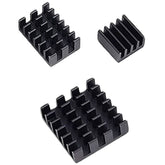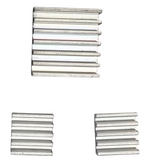How to attach heat sink to raspberry pi 4
Summary
Discover the secrets of keeping your Raspberry Pi 4 cool and efficient with our comprehensive guide on attaching heat sinks. Dive into the Introduction for a sneak peek into the importance of cooling. Learn to identify hot components and select the perfect heatsinks for your setup. We'll reveal the art of proper heatsink placement and share crucial enclosure and orientation tips. Don't miss our insights on firmware updates and maintenance to ensure long-term performance. Ready to supercharge your Pi? Read on for a cooler, smoother experience!
Introduction
Effective cooling is essential for the Raspberry Pi 4, the latest and most powerful iteration of the popular single-board computer.
Unlike its predecessors, the Raspberry Pi 4 packs a significant performance punch, courtesy of its beefy processor, enhanced graphics capabilities, and expanded memory.
However, with great power comes great heat generation, and if left unchecked, this excess heat can wreak havoc on your tiny computing powerhouse.
Overheating can lead to throttling, a protective mechanism that reduces the processor's clock speed to prevent damage from excessive temperatures.

While throttling helps safeguard your Raspberry Pi 4, it comes at the cost of diminished performance, negating the very advantages that make this board so appealing.
Proper cooling, on the other hand, ensures that your Raspberry Pi 4 can operate at its full potential, unleashing the raw computing power you paid for. Moreover, excessive heat can accelerate the degradation of electronic components, shortening the lifespan of your beloved Raspberry Pi 4.
By implementing effective cooling solutions, you not only maximize performance but also extend the longevity of your investment, ensuring many years of reliable service.
Before delving into cooling strategies, it's crucial to grasp the concept of overheating and throttling. When the Raspberry Pi 4's components exceed their maximum recommended operating temperatures, the board's firmware initiates throttling to prevent potential damage.
This process involves reducing the processor's clock speed, effectively slowing down the entire system.
While throttling is a protective measure, it can significantly impact performance, particularly during resource-intensive tasks like video encoding, gaming, or running complex applications.
Understanding this phenomenon is the first step towards implementing effective cooling solutions that keep your Raspberry Pi 4 running at peak performance.
Identifying Hot Components

The Processor
The heart of the Raspberry Pi 4 is its powerful Broadcom BCM2711 quad-core Arm Cortex-A72 processor, which can reach clock speeds of up to 1.5GHz.
As the primary workhorse, this processor is responsible for handling the bulk of the computational tasks and, consequently, generates a significant amount of heat.
Ensuring proper cooling for the processor is paramount, as excessive temperatures can lead to throttling, reducing performance and potentially causing long-term damage.
Neglecting to cool this critical component can severely hamper the capabilities of your Raspberry Pi 4, essentially negating the performance gains it offers over previous generations.
USB Controller
While the processor is undoubtedly the primary heat generator, other components on the Raspberry Pi 4 can also contribute to the overall thermal load. One such component is the USB controller, which manages the board's USB 3.0 and USB 2.0 ports.
The USB controller's temperature can rise significantly, depending on the number and type of devices connected to the Raspberry Pi 4.
For instance, power-hungry peripherals like external hard drives or high-speed USB devices can cause the USB controller to run hotter than usual, potentially leading to performance issues or even data corruption if left unchecked.
Ethernet Controller
Another component that can generate considerable heat is the Ethernet controller, responsible for managing the Raspberry Pi 4's gigabit Ethernet connectivity.
While not as critical as the processor or RAM, neglecting to cool the Ethernet controller can still lead to performance degradation, particularly when transferring large amounts of data over the network.
The Ethernet controller's temperature can rise due to sustained high-bandwidth network activity, such as streaming multimedia content or transferring large files.
Proper cooling can ensure that the controller operates within its recommended temperature range, preventing potential data loss or network instability.
RAM Chip
While the Raspberry Pi 4's RAM chip may not generate as much heat as the processor or other components, it can still benefit from additional cooling measures.
The Raspberry Pi 4 comes equipped with up to 8GB of LPDDR4 RAM, which can generate significant heat, especially under heavy workloads or when running memory-intensive applications.
Overheating RAM can lead to data corruption, system instability, and even hardware failure in extreme cases.
By implementing effective cooling solutions for the RAM chip, you can ensure reliable and consistent performance, even when pushing the limits of your Raspberry Pi 4's memory capabilities.
Choosing the Right Heatsinks
Heatsink Packs for Raspberry Pi 4
One of the most popular and effective cooling solutions for the Raspberry Pi 4 is the use of heatsinks.
These compact metal components are designed to dissipate heat away from the critical components, helping to maintain optimal operating temperatures. Many manufacturers offer pre-assembled heatsink packs specifically designed for the Raspberry Pi 4.
These packs typically include three or four heatsinks, with the larger heatsink intended for the processor and smaller ones for the RAM, USB controller, and Ethernet controller.
Copper vs. Aluminum Alloy Heatsinks
When it comes to heatsink materials, you'll often encounter two main options: copper and aluminum alloy.

Copper heatsinks are generally considered superior due to their exceptional thermal conductivity, which allows for more efficient heat transfer away from the components.
However, copper heatsinks tend to be more expensive than their aluminum counterparts.
Aluminum alloy heatsinks, while not as effective as copper, still offer decent cooling performance at a more affordable price point.
When selecting heatsinks for your Raspberry Pi 4, consider your budget and cooling requirements to strike the right balance between performance and cost.
Thermally Conductive Adhesive Tape
Many heatsink packs designed for the Raspberry Pi 4 come with pre-applied thermally conductive adhesive tape.
This specialized tape serves as a thermal interface material (TIM), facilitating efficient heat transfer from the components to the heatsinks.

Thermally conductive adhesive tape offers several advantages over traditional thermal pastes or greases.
It provides a consistent bond between the component and the heatsink, ensuring reliable heat transfer over time.
Additionally, the tape eliminates the potential for messy application or drying out, which can occur with traditional thermal compounds.
Proper Heatsink Placement

Applying the Processor Heatsink
The processor heatsink is the most critical component in your cooling arsenal for the Raspberry Pi 4. This larger heatsink is designed to fit snugly over the processor chip, providing maximum surface area for heat dissipation.
To apply the processor heatsink, start by removing the protective layer from the pre-applied thermally conductive adhesive tape. Carefully align the heatsink over the processor chip, ensuring that it makes full contact with the chip's surface.
Gently press down on the heatsink to secure it in place, allowing the adhesive to form a strong bond.
Heatsinks for RAM, USB, and Ethernet Controllers
While the processor heatsink is the most vital, neglecting to cool the other components can still lead to performance issues and potential instability. The heatsink pack typically includes smaller heatsinks designed for the RAM chip, USB controller, and Ethernet controller.
Follow a similar process as with the processor heatsink, carefully aligning and applying the smaller heatsinks over their respective components. Ensure that each heatsink makes complete contact with the component's surface to facilitate efficient heat transfer.
Ensuring Secure and Effective Contact
Proper contact between the heatsinks and the components is crucial for effective cooling. Even the slightest gap or air pocket can significantly reduce heat transfer, diminishing the effectiveness of your cooling solution.
After applying the heatsinks, gently press down on each one to ensure a secure and even contact with the underlying component.
If you encounter any resistance or unevenness, carefully remove the heatsink and reapply it, ensuring that the thermally conductive adhesive tape makes full contact with the component's surface.
Enclosure and Orientation Considerations
While heatsinks are an essential cooling solution for the Raspberry Pi 4, their effectiveness can be greatly enhanced or hindered by the enclosure in which the board is housed.
Choosing a well-ventilated case that allows for adequate airflow is crucial for maximizing the benefits of your cooling setup.
Look for cases with ample venting or open spaces, as these allow hot air to dissipate from the heatsinks and facilitate natural convection currents.

Avoid fully enclosed cases unless they incorporate additional cooling mechanisms, such as fans or active airflow management systems.
Another factor that can influence the effectiveness of your cooling solution is the orientation of the Raspberry Pi 4 board itself. While it may be tempting to lay the board flat for a low-profile setup, an upright orientation can actually improve convection and heat dissipation.
By standing the board upright, with the GPIO headers at the bottom and the HDMI ports at the top, you allow hot air to rise naturally away from the components and heatsinks.
This natural convection current can help extract heat more efficiently, reducing the overall operating temperatures of your Raspberry Pi 4.
For scenarios where passive cooling with heatsinks and proper case ventilation may not be sufficient, you can consider incorporating additional cooling fans into your setup.
Many Raspberry Pi 4 cases and kits include small, low-noise fans designed to improve airflow and actively extract hot air from the enclosure.
These fans can be particularly beneficial if you plan on running resource-intensive applications or operating the Raspberry Pi 4 in confined spaces with limited airflow.
By actively circulating air over the heatsinks, cooling fans can significantly enhance the overall cooling performance, ensuring that your components remain within their optimal temperature ranges.
Firmware Updates and Maintenance
Keeping Firmware Up-to-Date
While hardware cooling solutions are essential, it's also crucial to keep your Raspberry Pi 4's firmware up-to-date. The Raspberry Pi Foundation regularly releases firmware updates that can improve thermal management, power efficiency, and overall system stability.
Outdated firmware can lead to suboptimal thermal performance, potentially negating the benefits of your carefully implemented cooling solutions.
By keeping your firmware current, you ensure that your Raspberry Pi 4 operates with the latest optimizations and bug fixes, maximizing its cooling capabilities and overall performance.
Monitoring Temperatures and Performance
To effectively manage your Raspberry Pi 4's cooling requirements, it's essential to monitor the temperatures of critical components regularly.
Various tools and utilities are available that allow you to track temperatures in real-time, providing valuable insights into your cooling setup's effectiveness.

By monitoring temperatures, you can identify potential hotspots and take proactive measures to address them before they lead to performance issues or hardware damage.
Additionally, keeping an eye on performance metrics can help you determine if throttling is occurring, indicating the need for further cooling improvements.
Cleaning and Maintenance for Optimal Cooling
Over time, dust and debris can accumulate on the heatsinks and inside the enclosure, potentially hindering their cooling efficiency.
Regular cleaning and maintenance are crucial to ensure that your cooling solutions operate at their maximum potential.
Periodically remove the heatsinks and use compressed air or a soft brush to dislodge any accumulated dust or debris. Clean the interior of the enclosure, ensuring that no obstructions are blocking airflow paths or vents.
By maintaining a clean and well-maintained cooling setup, you can extend the lifespan of your Raspberry Pi 4 and ensure consistent, reliable performance.
Conclusion
In this comprehensive guide, we've explored the importance of effective cooling for the Raspberry Pi 4, identified the critical components that generate the most heat, and outlined various cooling solutions, including heatsinks, enclosure considerations, and additional cooling mechanisms.
We've emphasized the significance of proper heatsink selection and placement, ensuring secure and effective contact between the heatsinks and components. Additionally, we've discussed the role of firmware updates and regular maintenance in maintaining optimal cooling performance.
Proper cooling is not just a luxury for the Raspberry Pi 4; it's an essential requirement for unleashing the board's full potential and ensuring its long-term reliability.
By implementing the cooling strategies outlined in this guide, you can maximize performance, prevent throttling, and extend the lifespan of your beloved single-board computer.
As you embark on your Raspberry Pi 4 journey, keep in mind that cooling requirements may vary depending on your specific use case and workloads.
Monitor your system's performance and temperatures regularly, and don't hesitate to explore additional cooling solutions if necessary. Remember, investing in proper cooling is an investment in the longevity and reliability of your Raspberry Pi 4, ensuring that it continues to deliver top-notch performance for years to come. Embrace the world of efficient cooling, and unleash the true power of your Raspberry Pi 4.










